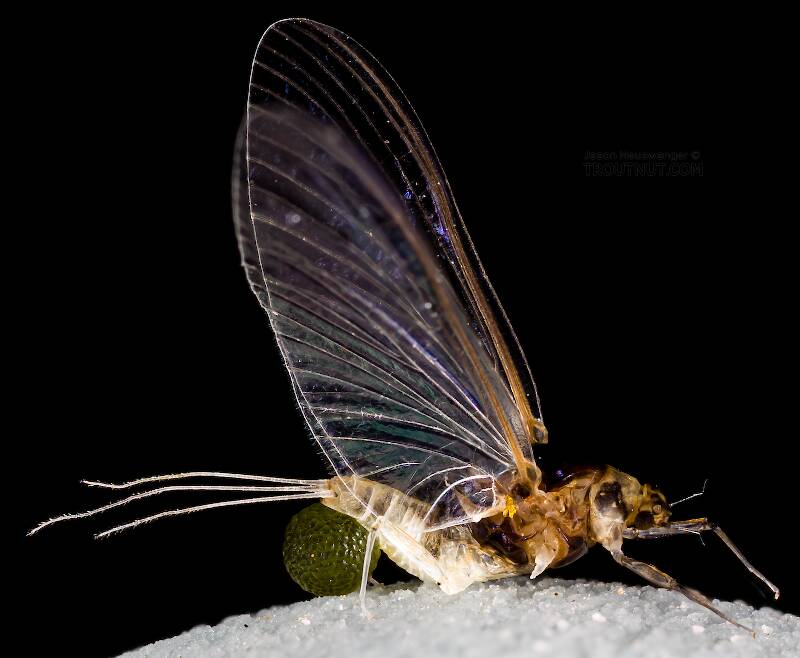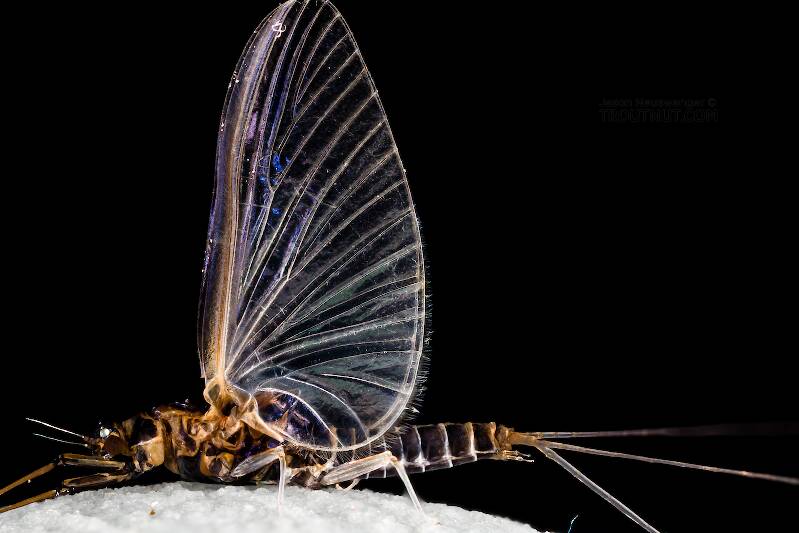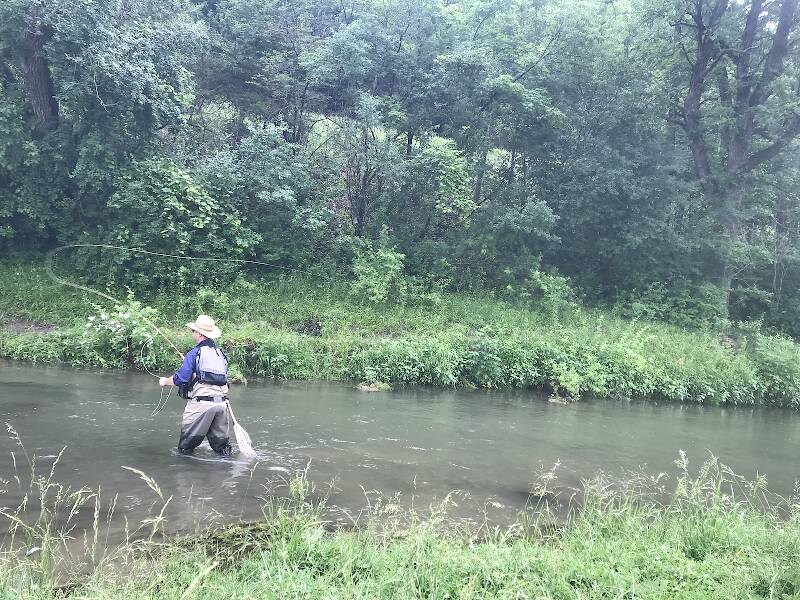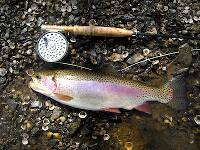
Salmonflies
Pteronarcys californica
The giant Salmonflies of the Western mountains are legendary for their proclivity to elicit consistent dry-fly action and ferocious strikes.
Featured on the forum

This dun emerged from a mature nymph on my desk. Unfortunately its wings didn't perfectly dry out.

Troutnut is a project started in 2003 by salmonid ecologist Jason "Troutnut" Neuswanger to help anglers and
fly tyers unabashedly embrace the entomological side of the sport. Learn more about Troutnut or
support the project for an enhanced experience here.
This topic is about the Mayfly Genus Tricorythodes
A cult following is something to which few insects can lay claim, but the tiny Tricorythodes mayflies certainly qualify. Their widespread, reliable, heavy hatches draw impressive rises of ultra-selective trout which demand the most of a technical dry-fly angler's skills.It is surprising that such a great hatch took so long to come to the attention of fly fishermen. The Tricos were first introduced to anglers in a 1969 Outdoor Life article by Vincent Marinaro, who misidentified them as Caenis. By the early 1970s the identification had been corrected but Swisher and Richards still wrote in Selective Trout, "Few anglers are familiar with these extremely small but important mayflies." The next wave of publications boosted Tricorythodes to its current fame. I suspect their early dismissal was due in part to tackle limitations; anglers in the 1950s had no means to effectively tie and present size 22-28 flies.
Example specimens
Martinlf on Dec 23, 2009December 23rd, 2009, 10:53 am EST
I just don't have a digital camera. Perhaps I'll get Caddisman to help me get some fly photos up this spring.
"He spread them a yard and a half. 'And every one that got away is this big.'"
--Fred Chappell
--Fred Chappell
Tilman on Dec 28, 2009December 28th, 2009, 4:46 am EST
http://winonaflyfactory.wordpress.com/category/fly-tying/
The third article is on the Trico. Is that the one you all are talking about ?
I have some very small hooks here and i will try that one anyway.
It´s like a gnat of some kind.
The third article is on the Trico. Is that the one you all are talking about ?
I have some very small hooks here and i will try that one anyway.
It´s like a gnat of some kind.
Oldredbarn on Dec 29, 2009December 29th, 2009, 7:12 am EST
Tilman,
Tricorythodes stygiatus (Trico) is a very small mayfly. Along with other tiny mayflies like Baetis cingulatus & Pseudocloen anoka, to name just a couple, have been known collectively as "The Fisherman's Curse". They are very easily missed due to their size. They are very prolific hatches, especially here in Michigan, and are of a long duration compared to some other mayflies.
Some version (cousins) of these bugs exist all across the US and are very worthwhile for an angler to know. I have had folks tell me that they never fish with a fly smaller than a 14, but I think they are missing out on some real fun...As you can tell from some of the earlier posts here...Small Fly fanatics are cut from a different cloth...Small rods (3-4 wts), sometimes only six and a half feet in length, and long fine tippets (7-8x).
These tiny mayflies are usually the culprit when you read or hear about the "Hidden Hatch". It is very easy to be fooled. Not so much with the Trico since they are about in the early morning, but some of the Baetis and the Pseudocloen can throw you if you are not careful.
In June, around Father's Day, on the Au Sable here in Michigan I have been waiting around for the dorothea (Pale Evening Dun/Sulpher) to start and for an hour or so before I start seeing them I have seen the fish feeding. If one looks really close you will see that they are on these small flies (Pseudocloen)...Add on some finer tippet and instead of waiting around for the Sulphers you can have a couple hours of fun fishing.
You mentioned "gnat"...I will confess that one April I was fishing over stockies in a put-and-take stream. There was little real food for these poor fish to eat except for a very tiny midge which they took without a problem. I had tied up only a half dozen of a very tiny imitation and and somehow burnt through them...In desperation I found a couple Trico's in the corner of my box...snipped off the tails...cut the wing back a bit, and I was back in business.
Take Care!
Spence
Tricorythodes stygiatus (Trico) is a very small mayfly. Along with other tiny mayflies like Baetis cingulatus & Pseudocloen anoka, to name just a couple, have been known collectively as "The Fisherman's Curse". They are very easily missed due to their size. They are very prolific hatches, especially here in Michigan, and are of a long duration compared to some other mayflies.
Some version (cousins) of these bugs exist all across the US and are very worthwhile for an angler to know. I have had folks tell me that they never fish with a fly smaller than a 14, but I think they are missing out on some real fun...As you can tell from some of the earlier posts here...Small Fly fanatics are cut from a different cloth...Small rods (3-4 wts), sometimes only six and a half feet in length, and long fine tippets (7-8x).
These tiny mayflies are usually the culprit when you read or hear about the "Hidden Hatch". It is very easy to be fooled. Not so much with the Trico since they are about in the early morning, but some of the Baetis and the Pseudocloen can throw you if you are not careful.
In June, around Father's Day, on the Au Sable here in Michigan I have been waiting around for the dorothea (Pale Evening Dun/Sulpher) to start and for an hour or so before I start seeing them I have seen the fish feeding. If one looks really close you will see that they are on these small flies (Pseudocloen)...Add on some finer tippet and instead of waiting around for the Sulphers you can have a couple hours of fun fishing.
You mentioned "gnat"...I will confess that one April I was fishing over stockies in a put-and-take stream. There was little real food for these poor fish to eat except for a very tiny midge which they took without a problem. I had tied up only a half dozen of a very tiny imitation and and somehow burnt through them...In desperation I found a couple Trico's in the corner of my box...snipped off the tails...cut the wing back a bit, and I was back in business.
Take Care!
Spence
"Even when my best efforts fail it's a satisfying challenge, and that, after all, is the essence of fly fishing." -Chauncy Lively
"Envy not the man who lives beside the river, but the man the river flows through." Joseph T Heywood
"Envy not the man who lives beside the river, but the man the river flows through." Joseph T Heywood
Tilman on Jan 4, 2010January 4th, 2010, 10:19 am EST
Thank you again, Spence, for this explanation.
The confusing thing about the term "Mayflies" for me is, that in germany the one to one translation would be "Maifliege", but that one is your "Green Drake".
Anyway, i think that i can (and will) use it on one occasion, or another.
One thing i am not yet sure about is the length of the wings and the tail.
Have you got any recommendations for that ? I looked at quite a few pictures by now and if my guess is correct, then the wings are fairly short and the tailfibres are fairly long, as far as proportion goes.
Ié already done 10 of them today, but i left the wings long enough to cut them down, if necessary.
The confusing thing about the term "Mayflies" for me is, that in germany the one to one translation would be "Maifliege", but that one is your "Green Drake".
Anyway, i think that i can (and will) use it on one occasion, or another.
One thing i am not yet sure about is the length of the wings and the tail.
Have you got any recommendations for that ? I looked at quite a few pictures by now and if my guess is correct, then the wings are fairly short and the tailfibres are fairly long, as far as proportion goes.
Ié already done 10 of them today, but i left the wings long enough to cut them down, if necessary.
Martinlf on Jan 4, 2010January 4th, 2010, 11:31 am EST
Hi Tilman,
I fish Tricos a lot. For as tiny as the bug is, the wing's no shorter than most mayflies, but the tails are long. However, I only tie tails on my Tricos when I need them for balance or flotation. Flies with no tails seem just as, or more, appealing to the fish. Trico imitations make good midge/gnat imitations for tiny bugs also. Best of luck.
--Louis
I fish Tricos a lot. For as tiny as the bug is, the wing's no shorter than most mayflies, but the tails are long. However, I only tie tails on my Tricos when I need them for balance or flotation. Flies with no tails seem just as, or more, appealing to the fish. Trico imitations make good midge/gnat imitations for tiny bugs also. Best of luck.
--Louis
"He spread them a yard and a half. 'And every one that got away is this big.'"
--Fred Chappell
--Fred Chappell
Bwoklink on Jul 14, 2018July 14th, 2018, 2:20 am EDT
My brother and I encountered a terrific trico hatch last year, but we’re unprepared. Believe or not, among the far too many patterns we brought, neither of us had anything smaller than a size 20. After an hour of frustration, my brother got irritated enough to throw on a elk H caddis to use as an attracter pattern. He didn’t clean house, but managed to catch a few. I didn’t think too much about this until later learning that a little brown caddis hatch can begin soon after the trico male spinner fall is petering out. Anyone else have experience fishing caddis patterns during a trico hatch? Also, I will never be caught on a stream in mid summer w/o patterns smaller than a size 20!
Wbranch on Jul 14, 2018July 14th, 2018, 3:49 am EDT
Bwoklink,
I dislike fishing a Trico spinner fall. In Montana where I fish for two weeks every late June to early July there is a phenomenal Trico dun emergence followed by an everyday epic spinner fall where millions of spinners are on the water. Often pods of fish are rising and sections of slow water appear to be riffled because so many trout are rising at the same time.
I often just refuse to tie on a Trico spinner and instead prefer to tie on a #20 CDC caddis. The trout are used to seeing the caddis and eat it jut as much as the Trico and I have no trouble seeing it on the water.
Anyone else have experience fishing caddis patterns during a trico hatch?
I dislike fishing a Trico spinner fall. In Montana where I fish for two weeks every late June to early July there is a phenomenal Trico dun emergence followed by an everyday epic spinner fall where millions of spinners are on the water. Often pods of fish are rising and sections of slow water appear to be riffled because so many trout are rising at the same time.
I often just refuse to tie on a Trico spinner and instead prefer to tie on a #20 CDC caddis. The trout are used to seeing the caddis and eat it jut as much as the Trico and I have no trouble seeing it on the water.
Catskill fly fisher for fifty-five years.
Martinlf on Jul 31, 2020July 31st, 2020, 6:04 am EDT
For Mike. By the way, I use Matt's dun pattern very early, before the spinner fall. It works. I'm sure he'll share it with you if you ask. I've also had some luck with this: use a Daiichi 1130 hook or similar scud hook in the proper size. Use 14/0 Veevus brown thread. Use dark brown very fine dubbing. Tie in a tail of some brown wet fly fibers and dub a very thin abdomen. Tie in a longish black spinner style wing of poly yarn where the abdomen ends. Dub a thorax in front of the spinner wing leaving 2 hook eye lengths bard just behind the hook eye. Tie in a short wing of fine snowshoe fur just in front of the thorax, then pull the spinner wing tips forward to create a wingcase around the wing, tying off the poly yarn at the eye. Whip finish and clip the extra poly yarn. I'm not sure that the wing case does anything but cause the tier extra trouble, but I do it anyway.
But mostly I just use Matt's cdc dun. I switch to spinners when I see them on the water. I landed an 18 inch wild brown a few weeks back on a spinner.
But mostly I just use Matt's cdc dun. I switch to spinners when I see them on the water. I landed an 18 inch wild brown a few weeks back on a spinner.
"He spread them a yard and a half. 'And every one that got away is this big.'"
--Fred Chappell
--Fred Chappell
Martinlf on Jul 31, 2020July 31st, 2020, 6:05 am EDT
Mike, Matt describes his dun on page 1. I just saw it.
"He spread them a yard and a half. 'And every one that got away is this big.'"
--Fred Chappell
--Fred Chappell
Partsman on Jul 31, 2020July 31st, 2020, 11:03 am EDT
Martinlf, thanks, I went through these threads and found tneals thread also, very helpful. I fished 7x last Tuesday, and did not change it when I went to the size 18 olives, bad move on my part, I had a big brookie power dive my Roberts size 18 and very quickly separated me from my fly! Im going to tie up some of Matts pattern, Matt is one of my heros here, thank goodness he puts up with us. Im hoping to get up north Thursday and Friday, weather looks good and I think this may be the best that summer has to offer. On a special note, please take care yourselves, and don't let things get you down. I now someone who did and he took his own life today, this is really bothering me at this time.
Mike
Mike
Martinlf on Jul 31, 2020July 31st, 2020, 12:18 pm EDT
You're welcome Mike. We all have a fish give us the slip at times. I lost a good fish to a bad knot the other day. Corkscrew at the end; it slipped. Good thoughts on staying positive. Also try the parachute spinner; it's very visible, and fish eat it confidently. I start with a white/clear post and if I can't see it I'll go to a colored one. Oh, try Stroft GTM 7X. It's very strong. Just check those knots.
"He spread them a yard and a half. 'And every one that got away is this big.'"
--Fred Chappell
--Fred Chappell
Quick Reply
Related Discussions
Topic
Replies
Last Reply
6
Sep 11, 2020
by Martinlf
by Martinlf
4
Sep 29, 2016
by Wiflyfisher
by Wiflyfisher
2
Jul 9, 2018
by Martinlf
by Martinlf
6
Oct 25, 2008
by Taxon
by Taxon
3
Jan 16, 2007
by Martinlf
by Martinlf










